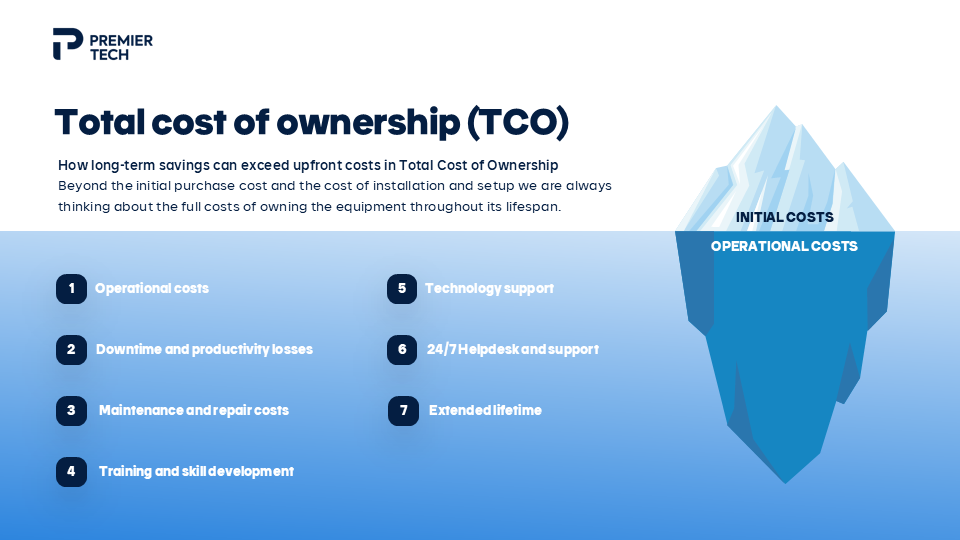Maximizing Value: Understanding Total Cost of Ownership for Long-Term Profit


Reading time: 8-9 minutes
The importance of Total Cost of Ownership (TCO) has been growing significantly the past few years, particularly as businesses have become more focused on the long-term perspective of their investments. While TCO isn't exactly a "buzzword," it has certainly grown relevance and importance in recent years due to evolving business priorities such as reducing operational costs, improving sustainability practices, and of course making smarter investment decisions in times of growing economic challenges. Companies are increasingly looking beyond the initial purchase price and focusing on the total economic impact of their investments over time. This shift is largely driven by the need to maximize value, especially in industries where margins are tight, global competition is fierce and efficiency is crucial.
How long-term savings can exceed upfront costs in TCO
In specific cases the longer-term recurring savings in TCO can sometimes even overachieve the initial price tag by providing significant cost efficiencies that compound over time. When businesses evaluate capital investments or capital expenditure (Capex) investments based exclusively on the upfront purchase cost, they risk overlooking ongoing costs such as maintenance, energy consumption, operational downtime, labor and many more.
For example:
- Equipment designed for durability and requiring minimal maintenance can save companies money by reducing repair and replacement costs, minimizing unplanned downtime, and boosting productivity.
- Accuracy and standard deviation in dosing, especially when handling more expensive bulk materials can also save companies significant sums of money just by dosing more accurately and consistently.
Over the course of the asset's life, these savings can accumulate and sometimes even exceed the initial price tag, providing a higher return on investment.
Quantifying the unquantifiable?
In the perfect world we can always and accurately quantify the elements of TCO in any specific monetary value, however this will not always be possible or as straightforward. Some TCO factors are easier to quantify, while others are more difficult due to their qualitative nature or variability. Within Premier Tech we often discuss the following elements of TCO with our clients:
- Initial purchase cost: This is straightforward and easy to quantify in monetary terms—simply the price tag of the asset.
- Installation and setup costs: These can often be quantified, including the cost of labor, any required infrastructure, and setup fees. However, the complexity of the installation may vary depending on the asset and the facility, so the costs can differ between companies.
- Operational costs: Think beyond energy-efficiency, labor and consumables. They may be harder to estimate due to variability, but increased output and product savings thanks to accuracy and standard deviation are quantifiable and can make a huge difference bottom-line.
- Downtime and productivity losses: This can be tricky to quantify in financial terms, as it depends on how much downtime affects the business’s revenue generation. However, businesses can use metrics like time required for spout changes and cleaning, lost production hours, lost sales, or opportunity costs to estimate the impact in Euros, though it may not always be perfectly accurate.
- Maintenance and repair costs: This is somewhat quantifiable. Routine maintenance or maintenance contracts and repair estimates can often be calculated. However, unexpected repairs or future service needs can be harder to predict and quantified precisely in advance.
- Training and skill development: Training costs are relatively easy to quantify in terms of fees, employee time, and any related materials. However, and although a given, the impact of better employee skills or reduced errors due to training may be harder to translate directly into financial terms.
- Technology support: Monitoring software and AI capabilities can help identify training needs or even reduce human errors. IoT can also trigger alerting for preventative maintenance. Also in this case, it could be challenging to quantify.
- 24/7 Helpdesk and support: If helpdesk and support contracts are part of the purchase, these costs can be easily quantified. However, under-used or non-used 24/7 helpdesk can also negate the potential ROI initially planned for.
- Extended lifetime with latest upgrades and retrofits: Lifetime of equipment can also be drastically extended by upgrading it with the latest technology at a lower cost compared to new equipment. By upgrading existing equipment, it will positively and quantifiably impact the TCO, however it might be harder to predict a monetary value today (both at investment and return) for an upgrade still to be designed in a decade or more to come.

Premier Tech partnering up with clients across the entire cycle
While the process can be more complex, the complexity is often necessary to avoid hidden costs that could affect the business in the future. Buyers must weigh the short-term cost savings against long-term expenses, which can involve a more detailed and time-consuming assessment across the product’s entire lifecycle.
By focusing on quality (durability, efficiency, accuracy, …) and supporting our clients during pre-sales, sales as well as post-sales, we pride ourselves at Premier Tech to partner up with our clients and grow overall understanding of TCO case-by-case and as such help clients manage and reduce the ongoing costs associated with their investments and ensure a higher return on investment over time.
Ready to get started with an automated packaging solution?
Discuss your project with our experts and get a recommendation suited to your specific needs.